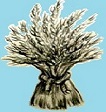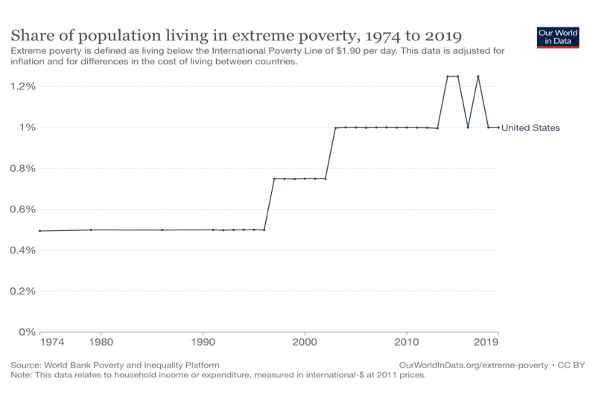Portrait of intractable poverty in the US (Statista, 2021)
Why does extreme poverty appear intractable? Some key ideas from classical social theorists V. Pareto, H. George, and T. Veblen indicate that poverty and intractable poverty stem from the human condition's intrinsic need for power. This power position is functioning through the modern apparatus of corporatism. We start with Henry George's view of the cause of poverty. Then, we look at the dynamics of wealth and poverty in Thorstein Veblen's writings. Finally, we examine the distribution of income and poverty in Vilfredo Pareto's sociological-economical writings.
Classic theorists
Henry George, born in 1839, concisely said people need to own the value of what they make. Yet, workers tend to accept the lowest amount of wage on which they can live and reproduce (George, 1905, p. Chap. 1). Owners and management in most business situations set the value of labor as hours of work to be paid, and this value is the cost of labor. So, the business owner has usurped the value of the product created through the worker's labor and parlayed it into the buildup of a more robust hierarchical structure, which ensured increased wealth for the owner.
George noted that in most economic theories, wages are not tied to production but to capital itself. Yet, it is the value of the product which produces capital. George explains that if capital generates wages, a circular argument ensues, i.e., substituting the word money for capital, 'money generates wages.' But the value produced by labor makes money (1905, p. Chap 2).
Henry George further noted that as individuals became more affluent, they acquired more land, and poorer folks, out of necessity, sold what land they had and became renters. (Henry George is not usually grouped with sociologists, but one could say he had a sociological imagination. According to Mills, a sociologist sees the crucial qualities of social relationships on a larger scale (1967, p. 225)).
And so, Henry George described the mechanisms that automatically widen the chasm between those with wealth and those in poverty. Namely, a poor person only survives by selling what he owns, including his labor and any property. Wealthy people have the money and talent to accumulate power and make more money. It is talent and luck that widen the wealth gap. A rich person acquires wealth so that the stochastic misfortunes of life are not catastrophic to their lives. Stochastic events include random shocks that happen to nearly everyone at some point in their lives. But wealth can largely offset luck. No one is immune from these random acts of misfortune. But wealth often determines the survival outcome.
Wealth has consequences. We look at Thorstein Veblen's theory of Conspicuous Consumption for the imposition of status maintenance. Thorstein Veblen studied overabundance as part of a hierarchical lifestyle. The lifestyle demanded a focus on excess as becoming a primary need for people with wealth, i.e., competition and the dynamic of assertiveness (Veblen, 1899, p. Chap.4).
The institution of a leisure class affects not only the social structure but also the individual character of the members of society (Veblen, 1899). Not only do the wealthy try to outdo each other but the poorer classes aspire to imitate the wealthier.
Veblen does not dismiss the value of the wealthy, although he is harsh in describing them. Veblen interchanges his terms for the enormously wealthy as the leisure or the pecuniary class. He does call them "parasites and predators. The institution of property laws is to further and guarantee the economic integrity and growth of their wealth" (Veblen, 1899, p. Chap. 8). When power brings operational control over more individuals, and they in turn accumulate power, the exponential gains at the top of the hierarchy result in a power law function.
Although dated, Pareto's power law roughly described the results of seeking power. Pareto noted that 20% of the people hold 80% of the wealth (Pareto, 1966/1935).
When we look at UN goals for poverty elimination, what we see missing is that people, according to the UN, need to be given something, equality of protection (UnitedNations, 2022). But wealth is held by a minority of the people as noted by Pareto. That wealthy minority is concerned with its small circle (Veblen, 1899). But individually they seek greater wealth. Pogge tries to make the argument that if we exist in society, we have an obligation to take care of others less well off than we are (2008, pp. 71, ff.).
This situation, where the rich get richer, and the poor get poorer, is the natural order of things. We can look at the hierarchical buildup of cities, hillocks in a river, and probably much of the distribution of money in corporations to see Pareto's law in this hierarchical buildup or power law. Blair Fix ascribes to corporate hierarchy the sole cause of high salaries for top executives (2018). The key idea of Pareto is elites govern in a closed system. Many governments have shifts in the people who control the government, but power tends to be a closed system when speaking of influencing the laws that favor retaining money and power (Pareto, 1966/1935, p. 121).
Conclusion
The global efforts to alleviate poverty are on a macro scale. These efforts are analogous to the eradication of the disease Polio. The eradication efforts are agency led and administered, and the result is the near eradication of the disease. However, intractable poverty is more like a broken leg or infection, requiring immediate real-time personal intervention. Currently, there is no mechanism or paradigm to effectively accomplish the task of financial intervention available to remedy bad fortune.
It was the contention of this paper to demonstrate the wisdom of the opening statement that poverty will always be with us because humanity, its nature, has not changed. There are always the elements of threat, power accumulation, and preservation of one's interests implicit in human nature.
The classical sociologists Pareto, Veblen, and George highlighted the underlying drives of the industrialization era, of which they were citizens. Although we live in a post-industrial society, basic humanity has not changed, and land is still real estate that is acquired and rented as Bill Gates has done in 2022, acquiring over 260,000 acres (Cochran, 2022). To the intrinsic value of land, our modern era adds the intellectual ownership of ideas in business, health, and social media. Ownership and rental of needed services for a living have always been part of civilization.



Add new comment